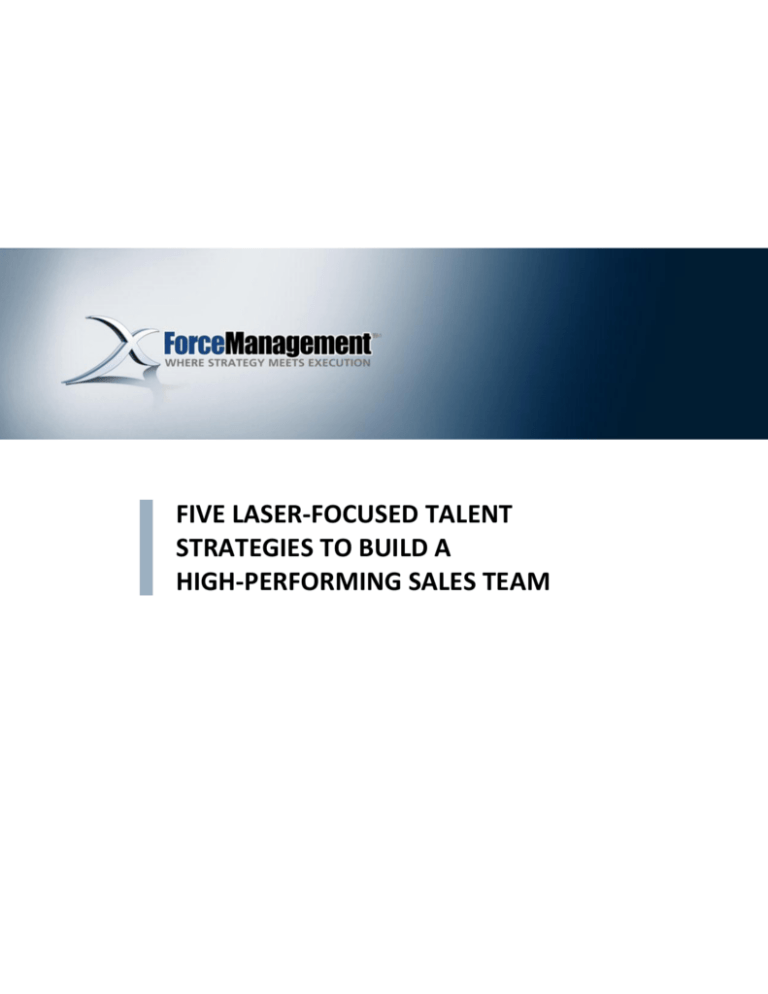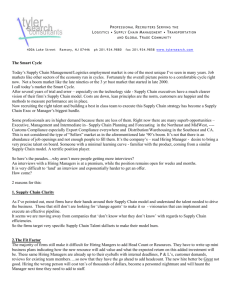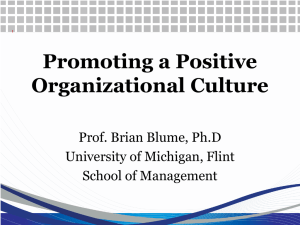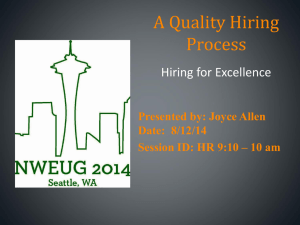Build A High-performance sales Team
advertisement

FIVE LASER-FOCUSED TALENT STRATEGIES TO BUILD A HIGH-PERFORMING SALES TEAM FIRST WHO, THEN WHAT In Jim Collins’ NY Times Best Seller, Good to Great, there’s a chapter called First Who, Then What. In it, Collins makes the point that great companies always consider the “who” questions before the “what” questions. His point is simple: companies must get the right people on the bus, and the wrong people off the bus, before figuring out where to drive the bus. He uses the metaphor to emphasize the ultimate rigor needed to make the people decisions that take a company from good to great. Larry Bossidy, former Chairman and CEO of Allied Signal (and then Honeywell, when acquired by Allied Signal in 1999) outlined his “people priorities” in the Harvard Business Review: “I devoted what some people considered an inordinate amount of emotional energy and time – perhaps between 30% and 40% of my day for the first two years – to hiring and developing leaders. I’m convinced that Allied Signal’s success was due in large part to this commitment.” Despite overwhelming evidence and numerous examples cited by Collins, he concedes that in most organizations today, talent management takes a back seat to almost every other undertaking in a company. Managing the Who No doubt, prioritizing the “who” questions would help most organizations make better people decisions. But many companies face a second, even greater challenge – the lack of a successful talent management process. To truly leverage the human side of business sales, leadership must have a clear line of sight. Without a clear set of standards and procedures, leaders have little ability to retain and grow their most successful sales people. For these companies, creating a talent management system looks like a daunting task. But a quick calculation makes it easy to understand why doing nothing can cost your sales organization more than moving forward with the development of a talent management system. In his book, Top Grading, Dr. Bradford Smart quotes national statistics that estimate the current cost of a hiring mistake at more than $800,000 for an individual who is compensated in the $50,000 - $100,000 range. Now think of your own example – someone you hired who didn’t work out or someone on your current team who’s not working out now. To find out what that one bad hire may have cost your company, use our Cost of a Bad Hire Calculator to identify your bottom line expenses. Any way you slice it, it’s a costly, frustrating situation that no sales manager wants to face. But a clear definition of success and five laser-focused talent strategies can help you recruit, select, onboard, develop and retain top sales talent for your organization. STRATEGY #1 – KNOW THE DNA OF YOUR PERFECT NEW HIRE What does success look like in a sales role in your company? It may not look the same as success looks in other companies. It also may not look the same as it did last year in your own company because of shifting go-to-market strategies, a merger or acquisition or the changing economic environment. Don’t be satisfied with a generic definition of success. Everyone wants an employee who is highly motivated, intelligent, disciplined, has positive energy, etc. But those generic characteristics could apply to almost any professional role in almost any company. 2 Instead, define what success looks like in a sales role at your company and incorporate that definition into a hiring profile. Unclear job requirements in the sales organization lead to positions that are not well matched to the strengths of an individual. To get the right person into the right job, hiring managers need definitive hiring profiles complete with sales job descriptions, desired behavior profiles and interviewing tools to help reveal levels of sales competency. Hiring managers should detail job descriptions and performance expectations down to measurable levels of knowledge, skills and behaviors. Then qualified candidates should be validated based on industry knowledge, required skills and job performance in their previous companies. Giving managers the ability to pinpoint the desired characteristics, along with defining performance potential consistent with the organization’s broader objectives, will lead to placing the right people in the right positions. If your sales organization hasn’t defined the DNA of your top performers, then your hiring profiles are probably off target. Start by asking the top performers on your sales team these three questions: 1. 2. 3. How would you define success in your current sales roles? What specialized knowledge do you possess? What particular skills and behaviors make you successful? Using these questions as a starting place will help you build a success profile. When you consider a new candidate for your team, you will be able to assess him or her against the top performers in your sales organization. Creating a Success Profile Once you determine some common competencies and behaviors of individuals currently performing this job successfully, you can create a very specific success profile for this individual and this job. A success profile differs from a hiring profile. It is a not a job description. It’s a profile of your perfect seller’s DNA. It’s a combination of the success competencies - knowledge required to effectively perform the job, and the success behaviors - what competencies look like in action when the job is being performed effectively. A behavior is not a success behavior if it can’t be observed or measured. It’s only by defining the DNA for the role and the candidate that you can effectively source, evaluate and develop the role moving forward. The Gift That Keeps On Giving Think of the success profile as the gift that keeps on giving. When you start by clearly defining the knowledge, skills and behaviors people need to succeed in your sales organization, you’ve painted a picture of what success looks like. The success profile will then further provide an integrated set of tools for: Selecting and acquiring talent Onboarding and assimilating Managing and rewarding performance 3 Developing and retaining talent Workforce planning and talent review Leading and promoting The Importance of Getting It Right A Harvard Business Review study concluded that up to 90% of all hiring decisions are based on the interview, yet a similar study by Michigan State University found that interviews reveal only a 14% accurate view of the candidate. That’s why a well-structured interview process is so important. Once a success profile is in place, you can leverage interview guides to identify your top candidates for the job. Creating an interview guide will allow you to reliably identify characteristics in candidates that lead to successful hires. Ask questions designed to verify competencies and behaviors. Use open-ended discovery questions to force the candidate to articulate concrete examples. Open-ended interview questions might start with a phrases like, “Tell me about a time,” “Walk me through,” or “Describe for me...” How It Works Competencies Behaviors Interview Questions Competency Client Interaction Behavior Proactively expand key relationships throughout the client organization Interview Question “Tell me about a time when you lost a key relationship within an account. Describe your situation, your response and what if anything you do differently now when managing relationships in your account.” Luca Lazzaron, former Senior Vice President WW ESM Sales at BMC Software adopted this approach. He created formal role expectations, performance assessments and interview guides for key sales and software consulting positions. After the implementation, he noted the following immediate benefits: The interview process was more rigorous and focused on the key qualifications needed to be successful. The candidate’s qualification or lack of qualification emerged quickly based on the evidence and knowledge gained in the interview process. The process created a common organizational language and saved time in preparing and conducting the interview and in discussing hiring decisions with the leadership. Hiring decisions were made more quickly, fairly and confidently through the use of a clearly defined systematic approach. A talent management program should provide the structure and techniques to accomplish all the above. It should also validate a qualified candidate based on personal characteristics, knowledge and job performance in previous companies. Lastly, it should give managers the ability to pinpoint the desired characteristics and performance potential that is consistent with the organization’s broader objectives. 4 STRATEGY #2 – FIND A DIAMOND IN THE ROUGH Based on the current economy and today’s unemployment numbers, you’re probably inundated with a large number of résumés when you post any sales position. As you’ll learn in the development of your success profile, a history of success at another company doesn’t necessarily guarantee a candidate’s success in your company. Your success profile will make your decisions clearer in the recruitment process by better preparing you to spot and qualify the talent you want. Defining success profiles and assessing candidates against top performers within your organization will ensure that you hire the best talent for your sales organization. Wading Through the Resumes Even with all the advances in communication and technology, the résumé remains the main source of qualification used by most companies. Once you have a detailed success profile for each role in your company, you can use it as a validation tool to quickly screen the résumés you receive. Though the résumé is a good start, be aware of the challenges of selecting the right candidates to interview. Most companies create a job description for an opening and then post the job description in the marketplace. This process allows applicants to alter their résumés to better fit your job description. A recent Cors Survey on Human Resource Issues revealed that: 46% of HR professionals believe falsification on résumés is significant, very significant or extremely significant. Those résumé items falsified most often include: Length of Employment Past Salary Job Responsibilities Skills So when screening résumés, keep in mind the strengths and limitations of this particular tool and scrutinize each résumé accordingly. Use a résumé to: Recognize the résumé’s limitations: Determine past behaviors to predict future success It may be too brief to make a hiring decision without indepth discussion Chronologically review to reveal patterns It often focuses on accomplishments instead of competencies and skills Examine specific accomplishments highlighted It tells “what” the candidate has done, but not how or what others thought of the performance Get a sense of individual’s growth, decision making and overall capabilities It can be structured to hide gaps or problems in performance 5 Check References – It’s Worth Your Time Some résumés include a list of references, while other candidates prefer to provide their references upon request. Since almost every hiring process includes asking for references, it’s hard to believe that many companies fail to check those references before hiring a candidate. When asked why, many respond with, “A candidate is only going to give us positive references anyway,” or “It slows down the process to contact references and play phone tag.” Bottom line – a person’s references reveal a great deal about the candidate. You may expect glowing references, but the truth is you might not always get them. With a Reference Check Guide in place, you can create a set of questions designed to get you the answers you need. Reference Check Guides – With set reference questions on hand, you can prevent a reference call from turning into a friendly chat during which you don't obtain the information you need to make an objective decision. You can also more easily compare candidates and ensure you are asking the "right" questions. Reference check questions might include, “Tell me about the candidate’s most important contributions to your organization,” and “Describe the candidate's productivity, commitment to quality and customer service.” To expedite contacting references, have a contact process in place as well, which could include telling your candidate to contact the references and let them know to expect a call. When you have trouble reaching a reference, have the candidate contact them again and remind them of the importance of the conversation. Keep in mind – if you’re having trouble getting someone listed as a reference to call you back – it may speak volumes about your candidate. Source the “Not in Play” Players Just because you have more applicants than openings, you still may not attract the best talent. So while officially posting the position to the outside world may be a necessary evil, don’t skip your best source for finding a diamond in the rough. Very often, you’ll find your best candidates are the “not-in-play players”– salespeople who aren’t currently looking for a job, but may be interested if they know more details about your open position. Savvy hiring managers are always recruiting with every call, in every conversation. Here are some techniques they use to find candidates: Ask New Hires – Make a habit of checking in with new hires during their first few days and weeks on the job to get the names of others they might know who might be good players on your team. Consider Customers and Champions – Ask your customers, “What sales teams have impressed you the most and why?” or “Who would you buy from if they had a better product?” They may have names of people who would be a good fit for your team. Network – Be committed to building your team with the best people you meet and come in contact with. Over time, work to develop relationships that could lead to someone you know entering into a successful relationship as an employee with your company. Reference Checks – An alternate benefit of doing reference checks is to potentially identify more candidates. After asking the specific questions about your current candidate, remember to add one more at the end of the conversation for sourcing new candidates. “Our company is constantly looking for good candidates like this one. Do any other contacts that meet these qualifications come to mind?” 6 STRATEGY #3 –TRANSFORM NEW HIRES INTO SUCCESSFUL SELLERS Top candidates tend to look for a company that can clearly define what success looks like in the role for which it is hiring. They look for that picture of success to be very consistent throughout the recruitment process. And once hired, they also expect to be on-boarded in a way that will prepare them for success within your company. So your onboarding processes, including orientation, job description and ongoing reviews should be treated as integral pieces of your employee success model. A good success profile ensures that you detail job descriptions and performance expectations down to measurable levels of knowledge, skills and behaviors. Mapping your quarterly employee assessments to the competencies and behaviors from the success profile will be easy for new hires to understand. The best onboarding practices include an onboarding checklist and a template used to orient new hires and track progress through their first six months. The list takes the goals and objectives of the position and creates modules of information around each. A good onboarding program should address: Performance expectations – Reviewing what you expect from a new employee can mean a significant reduction in misunderstandings which often lead to the premature departure of a new hire. Company|Departmental overviews – Making introductions and providing overviews of departments and the contacts within them is key to help a new employee get acclimated. Job description review – Going over the job description once again in the context of the workplace may give greater clarity and direction. Company policies and procedures – This might include spending review time with human resources within the first day or two of employment. Administrative housekeeping items – Getting a clear idea of how phone systems, computer programs, apps, inter office email, etc. work will give a new hire confidence and reduce down time in the first few days or weeks of hiring. STRATEGY #4 – MANAGE FOR SUCCESS Again, best-in-class companies turn to their success profile for managing and rewarding sales performance. They use it to set sales standards, drive accountability, manage to expected results and retain top performers. Extending those clear sales job descriptions to techniques for coaching and evaluation should be an integral part of your employee success model. To support the sales rep and your sales managers, make sure you have valid, measurable assessments that transfer smoothly to sales performance and professional growth opportunities. This approach promotes employee satisfaction, as talented individuals are encouraged to advance and are recognized and rewarded for taking initiative and providing more value to the organization. This approach is equally vital for addressing knowledge deficiencies. Inconsistent enforcement of sales standards and procedures leads to low accountability and lack of commitment. With onboarding measurements in place, you can now leverage the success profile framework to build management processes and tools to support individual and team performance. These tools can be invaluable in helping your managers to coach, motivate and lead a high-performing sales team. 7 Coaching Guides – assist managers in the inspection and remediation of desired selling behaviors. Quarterly Assessments – depict an individual’s current level of skills and knowledge based on competencies and behaviors from the success profile. Developmental Action Plan – outlines a plan to address and close the gaps identified in the Quarterly Assessment. Team Capability and Succession Review – combines individual scores to assess the entire team on its current level of performance and potential. Best-in-class companies have clearly defined organizational roles and responsibilities and appropriate standards and measurements in place to evaluate performance. With the right tools at hand, necessary improvements can be made quickly and companies can advance, strong and ready to succeed. STRATEGY #5 – RETAIN YOUR BEST TALENT The Gallup Organization interviewed over 80,000 employees in more than 400 companies and published their findings in the book First Break All the Rules. The interviews revealed that strength in the workplace could be found in the answers to just twelve questions. Overwhelmingly, the top performers in the top companies answered positively to these questions (in this order): The Measuring Sticks: 1. 2. 3. 4. 5. 6. 7. 8. 9. 10. 11. 12. Do I know what is expected of me at work? Do I have the materials and equipment I need to do my work right? Do I have the opportunity to do what I do best every day? In the last seven days, have I received recognition or praise for doing good work? Does my supervisor, or someone at work, seem to care about me as a person? Is there someone at work who encourages my development? At work, do my opinions count? Does the mission/purpose of my company make me feel my job is important? Are my co-workers committed to doing quality work? Do I have a best friend at work? In the last six months, has someone at work talked to me about my progress? This last year, have I had opportunities to work and grow? Take a minute to consider this – if you asked these questions to your sales team, how would you measure up? It’s clearly evident that “knowing what is expected” emerges as the most critical component in the satisfaction of top employees, proving that setting clear expectations is a critical, fundamental thread running through the entire employee experience, from the hiring process, through coaching, development and retention of top talent. Developing and Retaining Talent Developing and retaining your top talent is all about higher sales performance, deeper bench strength, reduced turnover and more valuable client relationships. The vision of future leadership should be defined and internal talent should be reviewed consistently so that key roles have contingency plans. Sustainability – the building of the leadership pipeline – ensures appropriate bench strength to support future business growth. 8 Know What Success Means For a talent development initiative to thrive, it must be supported by a viable strategy at every level, from top executive leadership to management to sales staff. It should also help drive distinct departmental efforts through a common vision and belief system. When you create and utilize a success profile, you’ll leverage it again and again throughout an employee’s lifecycle for: Selecting and acquiring talent Onboarding and assimilation Managing and awarding performance Developing and retaining talent Workforce planning and talent review Leading and promoting Summary It all comes back to where we started: great companies consider the “who” questions before the “what” questions. Managing the people side of your business requires building a successful talent management programs using three critical elements: A Successful Talent Management Program Produces: Better hires Enhanced staff development Reduced involuntary turnover Better succession planning Enhanced coaching skills 1. A simple and consistent set of processes for managing your people 2. An established rhythm so that you know you are executing the right things at the right time 3. A toolkit to help simplify the management of your people A successful talent management program will help you achieve quicker time-to-productivity, lower turnover and improved sales coaching and development skills. But in order to attract – and keep – the right people in the right jobs, you’ll also need effective a clear definition of what success looks like, an integrated set of hiring tools and consistent processes for recruiting, interviewing, onboarding, coaching and developing your talent. The right investment in talent management will provide your sales organization a clear pay-off where it matters most – in the numbers. 1 Jim Collins, Good to Great, HarperCollins Publishers, 2001 2 Dr. Bradford Smart, Topgrading: How Leading Companies Win by Hiring, Coaching, and Keeping the Best People, Prentice, 1999, 2005 9 10








